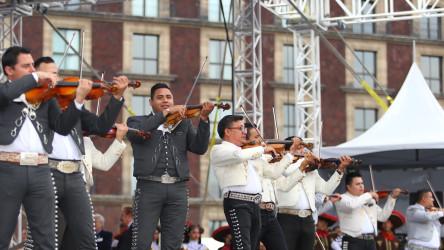Hanukkah, the eight-day festival of lights, commemorates the liberation of Jerusalem during the Maccabean Revolt. Under the reign of Antiochus IV, the Seleucid king of Syria, Jews were forbidden from practicing their religion and ordered to worship the Greek gods instead. In 164 BCE, Judas Maccabeus and his followers, known as the Maccabees, led a successful campaign to capture Jerusalem, after which the Temple was ritually cleansed and the altar rededicated. The Temple menorah had only enough oil to last one day but miraculously burned for eight days and nights. In today’s Hanukkah celebrations, candles are lit in a menorah with room for nine candles—one for each night and the “servant” candle that is used to light the others, called the shamash or shammes. Traditional blessings and prayers are recited, songs are sung, and gifts are exchanged. The festival is also often celebrated by eating foods fried in oil, such as latkes (potato pancakes) and sufganiyot (jelly donuts). Here are five classical pieces to add to your playlist this Hanukkah, two with deep roots in the San Francisco Jewish community.
Handel, Judas Maccabaeus
“See the Conqu’ring Hero Comes,” the final movement from Handel’s oratorio Judas Maccabaeus
First performed at the Royal Opera House in 1747, Judas Maccabaeus became one of Handel’s most popular oratorios, second only to Messiah. Although Handel was not himself Jewish, his music, especially this oratorio, was apparently popular with London’s small Jewish community. Handel dedicated Judas Maccabaeus to the Duke of Cumberland, who, like Maccabeus, had quelled a threat to his people’s religion—the Jacobite Rising of 1745, during which James Stuart, the exiled Catholic pretender to the throne, had unsuccessfully tried to usurp power with the help of his French allies. You’ll probably recognize the tune from the final act, “See the Conqu’ring Hero Comes,” which has frequently been used in other contexts. Beethoven used it in a set of twelve variations for cello and piano, and Henry Wood incorporated it into his Fantasia on British Sea Songs (1905), which is regularly performed on the last night of the BBC Proms. The melody is also often paired with Hebrew lyrics as “Hava Narima” (“Let Us Raise a Flag and a Torch”) and is now a popular children’s song for Hanukkah.
Aaron Copland, Vitebsk
In Vitebsk (1928), one of the rare pieces in which he engages with Jewish themes, Copland explores a Jewish folk song from Saul Ansky’s Yiddish play The Dybbuk, for which Joel Engel had written the incidental music. Ansky and Engel had each collected material for the play—both the storyline and the music—from a series of ethnographic expeditions in Russia between 1912 and 1914. The folk song in question, Mipnei ma (“Why has the soul fallen”), supposedly originated in Vitebsk, a factory town of some 70,000 people in present-day Belarus.
Using quartertones—tones in between the ordinary notes of our Western scale that sound “out of tune”—and stabbing, dissonant harmonies, Copland sought to depict the harshness of Jewish life in Russia. Here, we see quite a different side of Copland from later works such as Appalachian Spring (1944) and Billy the Kid (1938). As opposed to the forthright melodies and open harmonies that characterized his later fascination with the landscapes of the American West, the recurring opening motive of Vitebsk seems instead to intone a haunting, wordless sorrow.
Hugo Adler, Hannerot Hallalu
The celebration of Hanukkah begins with a series of three benedictions, followed by the kindling of the lights. After the Hanukkah candles are lit, two liturgical texts are customarily sung or recited, hannerot hallalu and ma’oz tzur. Hannerot hallalu gives thanks for the miracle of the lights, emphasizing that they are sacred and meant only to be admired rather than used for any other purpose. Set for chorus and piano, Adler’s charming arrangement evokes the wonder of marveling at the twinkling lights.
Ernest Bloch, Avodat Hakodesh
Reuben Rinder, the cantor at San Francisco’s Temple Emanu-El from 1913 to 1959, played a key role in the promotion of Jewish music and musicians in the Bay Area and beyond. He commissioned many leading composers to write Jewish sacred music for Temple Emanu-El including Ernest Bloch, Darius Milhaud, Marc Lavry, Paul Ben-Haim, and Fredrick Jacobi, and helped launch the careers of violin prodigies Isaac Stern and Yehudi Menuhin. Two of these works, Bloch’s Avodat Hakodesh (1933, Sacred Service) and Darius Milhaud’s Service sacré (1947) became canonical settings of the Sabbath morning service.
Born in Geneva in 1880, Bloch emigrated to the United States in 1916, settling in New York. A highly sought-after composer and teacher, he became the first professor of composition at Mannes School of Music. He subsequently became the first director of the Cleveland Institute of Music in 1920 and headed the San Francisco Conservatory of Music from 1925 to 1930. He received the commission from Rinder at some point in the late 1920s.
In 1930, Bloch returned to Switzerland for nearly a decade to focus on composing, where he completed Avodat Hakodesh (1930–1933), a setting of the complete Sabbath morning service. Its text was drawn from the Union Prayerbook for Jewish Worship, the preferred liturgical source of the American Reform movement. Bloch wrote on Jewish themes throughout his career, including the Israel Symphony (1916), Trois poèmes juifs for orchestra (1913; Three Jewish Poems), and the Baal Shem suite for violin and piano (1923).
Avodat Hakodesh has been hailed as the first successful attempt to convey the Hebrew liturgy using the harmonic language of Western high art music, conceived as both a practical work meant to be performed in the context of Jewish worship and a transcendent concert work that was also applicable to a universal, humanistic spiritual experience. Featuring a solo baritone in the role of the cantor, a narrator (occupying the role of the rabbi), and a full chorus and orchestra, Avodat Hakodesh is a beautiful and moving exploration of the drama of the liturgy. Bloch’s material is almost completely original, hardly using any pre-existing liturgical tunes. The influence of composers such as Strauss on Bloch’s style can be heard in the grand scale of the orchestration, but the harmonic palette remains straightforward.
Darius Milhaud, Service sacré (1947)
Darius Milhaud, Service sacré Part 1: Ma Tovu
Composed in the wake of the Second World War, Service sacré forms part of the same lineage of Jewish sacred works commissioned by Rinder at San Francisco’s Temple Emanu-El. Milhaud immigrated to the Bay Area in 1940 following the Nazi occupation of France, and would never live in his home country again. He took up a teaching post at Mills College in Oakland and had a number of prominent composition students over the years, from jazz great Dave Brubeck to Steve Reich, William Bolcom, and Katharine Warne.
Although Service sacré was meant to be a setting of the Saturday morning liturgy, in many Reform congregations, the late Friday evening service was typically the main service people attended. To give the work a broader appeal for liturgical use, Milhaud added settings of some Sabbath eve prayers.
Unlike Bloch, who had mostly used original material as the basis of Avodat Hakodesh, Milhaud looked to his own Provençal Jewish heritage for inspiration, incorporating ample material from the Provençal rite, the minhag Carpentras. By then, this regional rite had almost disappeared from use. It is unclear to what extent Milhaud relied on his own childhood memories of religious services in Aix-en-Provence or turned to established historical sources. However, several of the tunes match up with a 19th-century source known as the Crémieu collection. While the melodies are the same, Milhaud often repurposes them. For instance, the opening prayer, Ma tovu, derives primarily from phrases in the Crémieu Yom Kippur Torah service. Milhaud effortlessly bridges sacred and secular idioms, combining chant melodies with striking, modern harmonies. Although rarely performed, Milhaud’s Service sacré undoubtedly deserves more attention.







